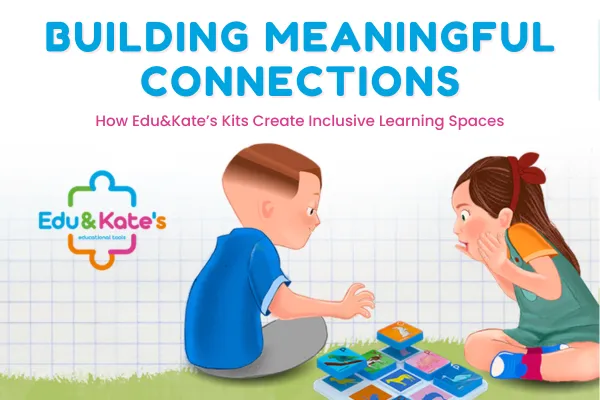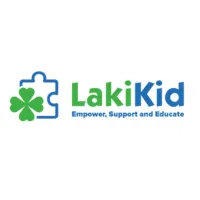Blog

Building Meaningful Connections Through Play: How Edu&Kate’s Kits Create Inclusive Learning Spaces
Play is more than just fun—it’s a powerful tool for learning, growth, and connection. For children with sensory sensitivities, engaging in play that meets their unique needs can make all the difference in their educational journey. Edu&Kate's was created to provide families, educators, and therapists with thoughtfully designed sensory-friendly learning tools that foster engagement, creativity, and confidence.
Why Play Matters in Sensory-Inclusive Learning
Imagine a classroom where every child feels engaged, supported, and understood. A space where learning is hands-on, interactive, and tailored to meet different sensory needs. Sounds like a dream, right?
For many parents and educators, creating such an environment is a challenge. Children with sensory sensitivities often struggle with traditional learning methods, requiring tools that cater to their unique ways of processing the world. This is where Edu&Kate's steps in—a brand born out of love, experience, and the need to bridge the gap between neurodivergent learners and meaningful education.
Edu&Kate's: A Parent-Led Solution with a Purpose
Edu&Kate's isn’t just another educational brand. It’s a heartfelt mission inspired by Pedro and his parents, who spent years searching for the right resources to support his learning journey. Frustrated by the lack of suitable options, they decided to create what they wished had existed—an inclusive, engaging, and fun way for children to connect with learning.
Their goal? To help parents, teachers, and therapists make education accessible and enjoyable for all children, regardless of their sensory needs. By combining Montessori principles with hands-on, sensory-friendly materials, Edu&Kate's has become a game-changer for inclusive learning.
Edu&Kate's Development Stages Guide
Understanding the 4 Stages of Development
At Edu&Kate’s, our educational games are designed to grow with your child. We've structured our activities into four key stages, each supporting different aspects of cognitive and motor skill development:
Stage 1: Early Learning & Object Recognition – Helps children recognize objects, form mental images, and associate real-life visuals with words.
Stage 2: Conceptual Understanding & Categorization – Supports mental image creation, memory skills, and classification of objects into groups.
Stage 3: Emotional Intelligence & Critical Thinking – Encourages problem-solving, recognizing emotions, and making connections between objects and ideas.
Stage 4: Advanced Language & Logical Thinking – Enhances reading and writing skills, puzzle-solving, and forming sequences and stories.
Stage 1: Early Learning & Object Recognition

In this stage, we have games that are perfect for kids who are just starting to learn about the world. These games use a lot of real images to help children understand and perceive the world around them. It's all about getting that initial knowledge, learning the basics of the world, and forming mental images and recognizing objects.
Match the Images
Place the top pieces inside the storage cup and take them out one by one, matching them with the corresponding image on the base.
The adult should say the word aloud, e.g., "Airplane!" and connect it with the real image of the airplane.
Create a sentence: “The airplane flies to Paris.”
Find the Object
Increase complexity by using two bases simultaneously.
Place all pieces inside the storage cup.
The child must retrieve and place the piece on the correct image as quickly as possible.
Super Bingo
Each participant gets their own game base.
All top pieces are placed inside the activity box.
The adult calls out each piece, and players check their base to cover the corresponding object.
The first to complete their board wins!
Syllable Game
Place pieces in the storage cup.
The adult gives a clue using the first syllable of an object’s name (e.g., "Wa" for watermelon).
Children guess the object.
Adapt clues based on children’s needs.
Stage 2: Conceptual Understanding & Categorization

During this stage, kids start forming mental images of familiar concepts, absorbing ideas about professions, actions, and shapes. They also begin grouping objects and understanding their surroundings.
Rhyme Game
Children pick an object and find a word that rhymes.
They repeat both words after the adult, using gestures or movements for interaction.
Describe & Guess
The adult picks a piece and describes it.
The child guesses the object based on verbal clues.
Group Objects
Scatter the pieces on a table.
The adult picks representative pieces for each category (e.g., Transportation, Professions, Musical Instruments).
The child sorts the remaining pieces into the correct categories.
My Routines
Using the Actions 1 board, ask the child questions like, “What do you need to brush your teeth?”
The child organizes pieces in order, creating a personalized routine.
Stage 3: Emotional Intelligence & Critical Thinking

Children in this stage develop logical thinking, emotional intelligence, and problem-solving skills.
I Understand You
Discuss emotions based on illustrated pieces.
Ask questions like, “How do you think this child feels?”
Relate emotions to real-life experiences.
Looks Like…
Draw associations between images (e.g., a penguin and an ice cream cone—both cold and white).
I Spy
A child picks an object they see and gives clues about it.
Others guess based on the clues.
Printable Board Game
Players roll dice and move their game piece.
When landing on an emotion, they express it and discuss when they’ve felt it before.
The first player to finish wins.
Stage 4: Advanced Language & Logical Thinking

In this stage, kids expand their vocabulary, recognize words without visual aids, and solve complex puzzles.
The Storyteller
The child selects game pieces to create a story.
The adult helps organize and narrate.
Drawing can be added to illustrate the story.
Fine Motor Skills
The child explores pieces, stacking them or placing them in a storage cup.
Introduce more challenging tasks as they progress.
Sequences
Organize pieces into categories.
The child follows a pattern (e.g., Color – Number – Color – Number).
Encourage them to create their own sequences.
Out of Context
Pieces from all three games are mixed together.
The child identifies which object does not belong in a set and explains why.
Sensory-Friendly Learning with Edu&Kate's Kits
Not all learning tools are created equal. Some overwhelm, while others fail to engage. Edu&Kate’s bundles are different—they're designed to stimulate, not overstimulate, and to encourage learning through touch, movement, and exploration. Let’s break down how these kits support sensory-friendly education:
1. STEM & Creativity Kits: Learning Through Hands-On Play
Encourage problem-solving skills with interactive activities that challenge young minds to think critically.
Develop fine motor skills through building, stacking, and manipulating objects, which helps with hand-eye coordination and dexterity.
Support multi-sensory engagement for learners who benefit from tactile input, allowing them to process information more effectively through touch and movement.
Foster imaginative play by integrating creative elements such as storytelling and open-ended exploration.
Provide collaborative learning experiences, making it easier for children to interact with peers in a structured yet flexible way.
2. Montessori-Inspired Tools: Independence and Structure
Designed to promote self-paced, guided learning that aligns with a child’s comfort level, allowing them to progress at their own speed without frustration.
Helps kids build focus and routine without feeling pressured by rigid expectations, encouraging them to develop a sense of responsibility for their learning.
Encourages decision-making and confidence in young learners, empowering them to choose activities that best suit their needs and interests.
Enhances practical life skills, such as sorting, sequencing, and organization, that translate to everyday situations.
Reduces sensory overload by offering structured yet calming activities that minimize distractions and maximize engagement.
3. Sensory Play & Regulation Kits: Aiding Focus and Calm
Offer tactile and visual stimulation to support emotional regulation, helping children manage their reactions to different environments and experiences.
Include tools like fidget-friendly objects, textured materials, and calming activities to ease anxiety and provide a sense of security.
Help children transition between tasks more smoothly by incorporating movement breaks and sensory-rich activities that reset focus.
Assist with self-soothing techniques, allowing children to engage in activities that naturally regulate their energy levels.
Encourage mindfulness and relaxation, helping kids develop coping strategies that they can carry into adulthood.
How to Use Edu&Kate's Products in the Classroom & at Home
Having the right tools is one thing. Knowing how to use them effectively? That’s where the magic happens. Here are some expert-approved strategies to integrate Edu&Kate’s products into daily learning:
1. Create Interactive Learning Stations
Dedicate areas for tactile play, quiet work, and movement-based learning to accommodate different needs and preferences.
Rotate materials and activities regularly to keep students engaged and eager to explore new concepts.
Designate a calm corner with sensory tools for children who need a break from stimulation.
Incorporate visual schedules to help children transition between learning stations with ease.
2. Support Non-Verbal Communication
Use visual aids and textured materials to help children express themselves when words fall short, fostering stronger communication skills.
Implement picture exchange systems to support children who benefit from structured visual communication.
Introduce tactile storytelling using sensory objects that bring narratives to life in an engaging and accessible way.
Encourage alternative communication methods like sign language or AAC (Augmentative and Alternative Communication) tools.
3. Encourage Choice and Autonomy
Let students select sensory-friendly activities that match their comfort level, fostering a sense of control and engagement in their learning.
Offer multiple learning options, allowing children to choose between hands-on tasks, visual-based exercises, or movement-based activities.
Provide task cards with step-by-step instructions so children can complete activities independently and build confidence.
Celebrate individual learning styles, reinforcing that there is no one-size-fits-all approach to education.
Real-Life Success Stories: The Edu&Kate's Impact
Nothing speaks louder than real experiences. Educators and parents who have incorporated Edu&Kate’s tools report:
Increased engagement from children who previously struggled to focus, showing a newfound enthusiasm for learning.
Improved social interactions as sensory play fosters collaboration, teamwork, and mutual understanding among peers.
Better emotional regulation through calming, sensory-based activities that help children manage frustration and anxiety.
Heightened curiosity and creativity, with students feeling more confident in exploring and experimenting with new ideas.
Stronger parent-child connections, as families use sensory play as a bonding tool to engage with their children in meaningful ways.
One teacher shared: “I’ve seen students go from overwhelmed to fully engaged just by introducing hands-on tools from Edu&Kate. It’s a game-changer for inclusive classrooms.”
A parent added: “For the first time, my child feels excited about learning. The sensory-friendly tools make all the difference in keeping him calm and focused.”
Ready to Transform Learning?
Creating an inclusive space doesn’t have to be complicated. With Edu&Kate’s sensory-friendly kits, you can unlock the full potential of every child through play, connection, and understanding.
Explore Edu&Kate’s collections today and start building a classroom that truly embraces every learner. Browse Edu&Kate’s Bundles & Kits Here!

Contact Us
(425) 999-7582
19580 West Indian School Road Suite 105-177, Buckeye Arizona 85396
